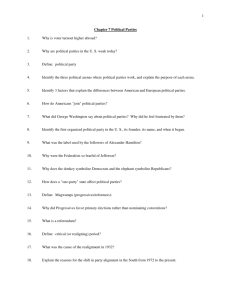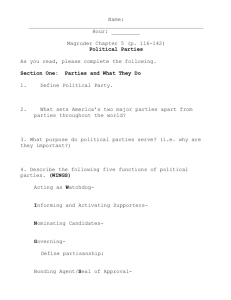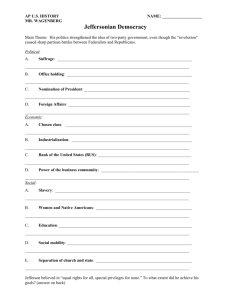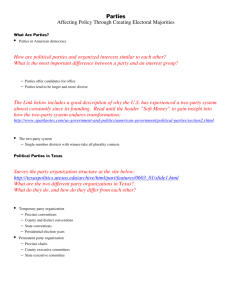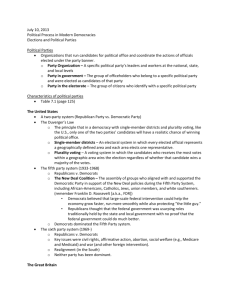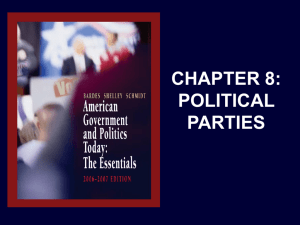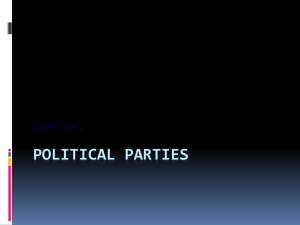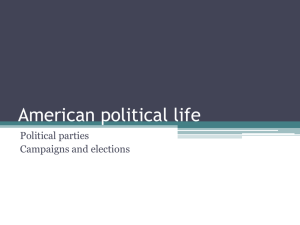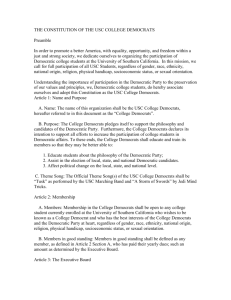Political Parties
advertisement
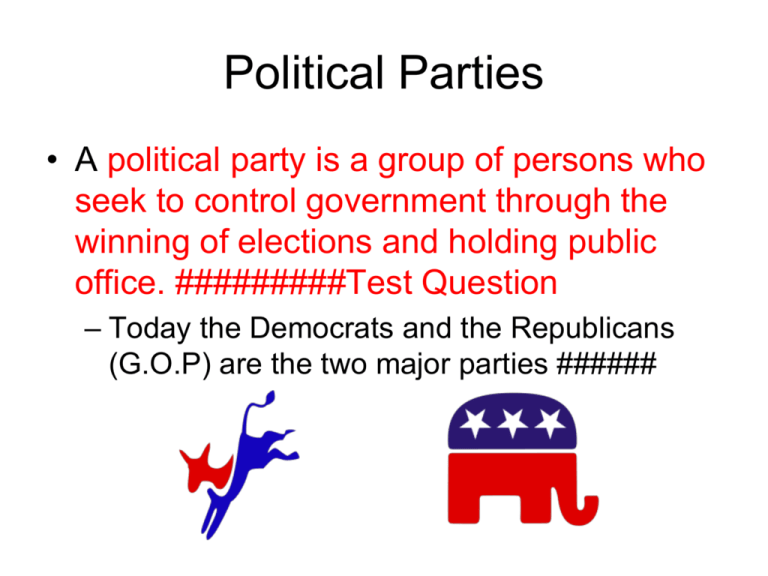
Political Parties • A political party is a group of persons who seek to control government through the winning of elections and holding public office. #########Test Question – Today the Democrats and the Republicans (G.O.P) are the two major parties ###### Political Party Functions • Nominating Candidates – parties select candidates and present them to voters as options • Informing and Activating Supporters – parties must inform the public and encourage their participation in government • The Bonding Agent Function – ensure the good performance of its candidates and officeholders • Governing – most government business is based on partisanship. – Most decisions made by political officeholders is based around how they think their party would want them to vote. • Acting as Watchdog – parties act as watchdogs over the conduct of the public’s business.#### – The party out of power, will often criticize the role of the party in power (the party that holds the most governmental positions The Two-Party System • • A political system dominated by two major parties. Reasons for U.S. two-party system #### 1. History – once Washington left office, government officials divided themselves between those that supported Hamilton (Federalists) and those that supported Jefferson (Anti-Federalists Reasons for Two-Party System (cont.) 2. The Force of Tradition – we have two major parties because that is the way it has always been done. Humans do not like change. 3. The Electoral System – The winner-take-all system of elections in the U.S. encourages only two parties to guarantee one side gets a majority of the votes. 4. The American Ideological Consensus – over time, the American people have shared many of the same ideals, principles, and patterns of belief. Single-Member Districts (SMDs) • A single member district is an electoral district from which one person is chosen by the voters for each elected office. – SMDs discourage minor parties because only one winner can come out of each contest. • You can either vote for the party in power, or for the party with the best chance of replacing the party in power. Some believe a vote for another minor party is a wasted vote. DEMOCRATS African-Americans Catholics Jews Union Members REPUBLICANS White males Protestants Business owners Party Membership Patterns • Factors that can influence party membership: Family Major events Economic Status Religion Occupation Age Two-Party System in American History • The first two real political parties were the Federalists and the DemocraticRepublicans. ###### – Federalists – founded by Alexander Hamilton, party of the “rich and well-born.” – Democratic-Republicans – founded by Thomas Jefferson, more sympathetic to the “common man” Four Major Party Eras 1. 2. 3. 4. The Era of the Democrats, 1800-1860 – Democratic domination until the Civil War, mostly due to disorganization by the opposition. The Era of the Republicans, 1860-1932 – The election of Abe Lincoln marked the beginning of 70+ years of GOP dominance. The Return of the Democrats, 1932-1968 – the Great Depression helped the Democrats regain control Divided Government, 1968-present – neither party can consistently hold the presidency, Congress is often controlled by the opposing party. Minor Parties • The Libertarian Party ##### – Stresses individual liberty, opposes taxes, foreign involvements, government intrusion into private lives • Prohibition Party ###### – Advocates a nationwide ban on alcohol • Constitution Party – Advocates “free pursuance of happiness, not the regulation of it.” • Communist Party USA – Terms itself, “the Party of the American Working Class.” Looks forward to the restructuring of the American political and economic systems. • Green Party ##### – Promotes environmental concerns with the slogan “We do not inherit the Earth from our parents, we borrow it for our children.” The Minor Parties • Types of “Third” Parties – Ideological parties – based on a particular set of beliefs (Communist party) ### – Single-issue parties – concentrate only on one publicpolicy matter (Prohibition Party, Green Party) ### – Economic protest parties – found in poor economic times, dissatisfied with current conditions and demanding better times(Occupy Wall Street) – Splinter parties – parties that have split away from one of the major parties (Bull Moose party, Dixiecrats) #### Roles of Third Parties #### 1. Spoiler role – even if they don’t win the election, they can pull enough votes away from one side to sway the election. 2. Critic – unlike the major parties, minor parties are ready, willing, and able to take clear-cut stands on controversial issues. They draw attention to issues, major-parties are trying to avoid 3. Innovator – Some of the most important issues have been brought up by minor parties, but stolen by major parties when the proposal gain a real share of public support. Party Organization • Party organization tend to be decentralized, meaning they have no chain of command from the top to the bottom, because: 1. The role of the presidency – the president is obviously his party’s leader, the opposition party has no clear leader. 2. The impact of federalism – there are more than half a million elected offices in the US, it is hard for one group to make all the decisions 3. The role of the nominating process – the nominating process is often a divisive one. National Party Machinery • 4 elements of both major parties – The National Convention – party’s national voice. Nominates candidates for president, adopts party rules, and writes the party platform – The National Committee – between conventions, the party’s affairs are handled by the national committee – National Chairperson – leader of the national committee, directs the work of the party’s headquarters, and its small staff in Washington – Congressional Campaign Committee – each party has one for each house in Congress. Works to reelect incumbents and ensure members of their party take open seats. State and Local Machinery • Although national party organization are largely the product of custom and of the rules adopted by the national conventions, state and local levels are set by State law. • At the State level, party machinery is built around a State central committee, headed by a State chairperson • Local party structures vary widely from place to place. Local units include congressional and legislative districts, counties, cities and towns, wards and precincts. 3 Components of the Party • • • The party organization – leaders and activists who control the party machinery The party in the electorate – the party’s loyalists who vote for the party in elections The party in government – party’s officeholders at all levels of government Why Have Parties Weakened? • Most voters in the United States do not identify themselves with one party or the other. • There has been a large increase in split-ticket voting, or voting for candidates of different parties • Parties are less organized and have greater internal conflict. This conflict results from primary elections • Changes in technology have made the media more important than the party in the spread of information • The growth in number and impact of single-issue organizations
